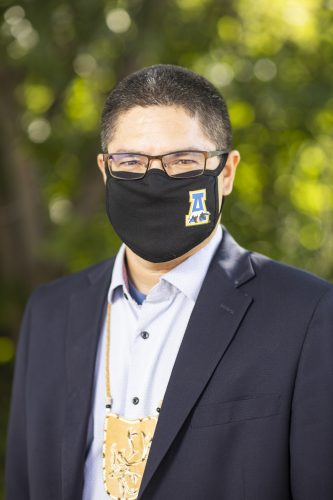Friday Focus: A Native American Heritage Month lesson
November 20, 2020

— by Evon Peter, vice chancellor for rural, community and Native education
This is Native American Heritage Month, as such an ideal time to dedicate my column to some thoughts on the topic.
I have been asked a lot about Indigenous land acknowledgments lately. At UAF, we acknowledge the Alaska Native nations upon whose traditional lands our six campuses reside. In Fairbanks, we are on the lands of the Dena’ Athabascan people of the Tanana River.
Each of our rural campuses are working on land acknowledgments for their areas. In all I expect the UAF campuses to include at least 13 of the 20 distinct Alaska Native nations. We use the word “nation” because Indigenous peoples fulfill the parameters that define nations, those being a distinct language, social structure, history and land base. Land acknowledgments are a means to begin correction of historical erasure and exclusion of Indigenous nations and to inspire action for more meaningful steps toward healing and reconciliation.
There is a long history of colonization and assimilation that explains why and how Indigenous nations were erased from the history books. An example of this history is the principle of “terra nullius” (nobody’s land) and the Doctrine of Discovery, which were used as tenets of international law to determine the right of European nations to claim ownership of the lands occupied by Indigenous peoples. Essentially, Indigenous peoples were determined to not possess the value of a human being and therefore did not possess human rights, including the right to own their lands.
The U.S. Supreme court utilized these principles to justify and make legal the theft of Indigenous land and subjugation of Indigenous peoples. It was not until 1924 that Indigenous peoples were granted U.S. citizenship and could begin to formally work from within the system to advance their human and civil rights. By that time a tremendous amount of physical, cultural and emotional trauma had been inflicted upon Indigenous peoples. Additionally, their lands had produced billions of dollars annually for non-Indigenous peoples, a source of great disparities in health and wealth to this day.
Our job now as educators is to integrate Indigenous knowledge, values and history into K-12 and university curriculum. Infusing Indigenous knowledge is beneficial to all people. It grounds us, literally, with knowledge of whose lands we live and work on, and it makes visible contemporary Indigenous communities. Ultimately, we can then together seek to address our communities’ current problems from this new perspective.
Seeing that it is also the month of the Thanksgiving holiday, I encourage you to read this article, “The Thanksgiving Myth Gets a Deeper Look This Year,” which highlights some of the issues surrounding this holiday and how it perpetuates false narratives about Indigenous peoples and the history of this country.
The reality is that this is not an easy or light history to learn about or teach, but it is essential if we are to move our country and civilization forward in a direction of healing and reconciliation, toward justice and equity. So, in this month of celebrating Indigenous peoples, let’s have conversations and take actions that uplift Indigenous narratives and help to move us all toward a better future.
Friday Focus is a column written by a different member of UAF’s leadership team every week. On occasion, a guest writer is invited to contribute a column.


